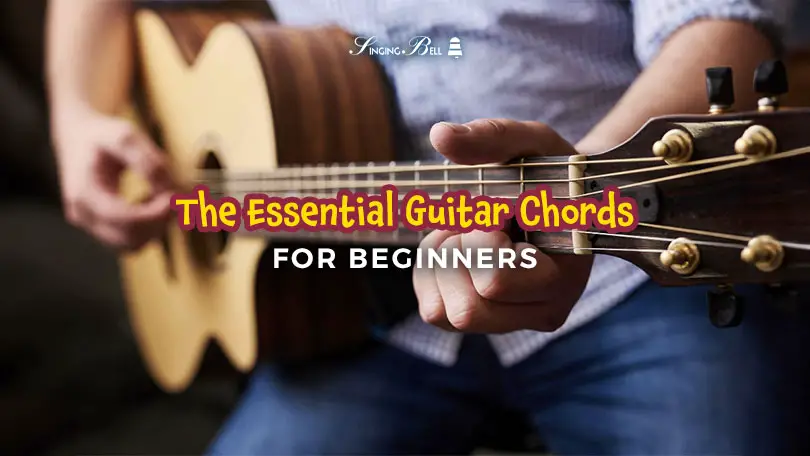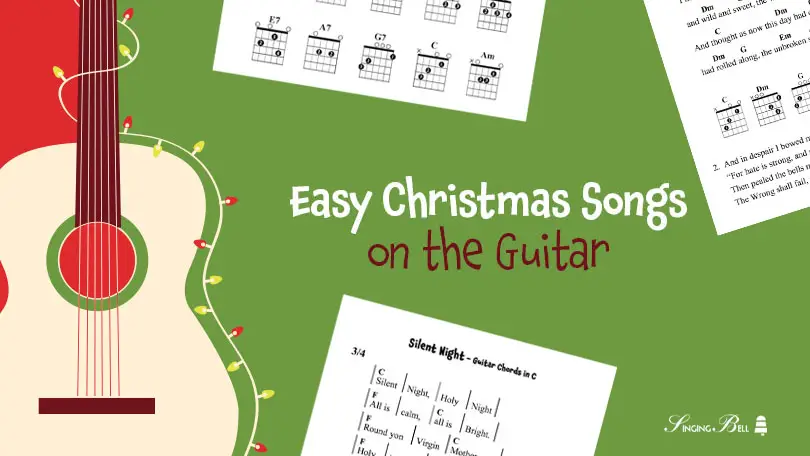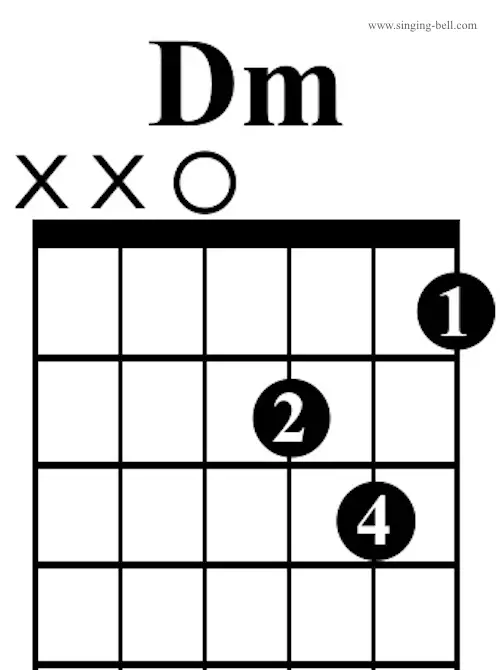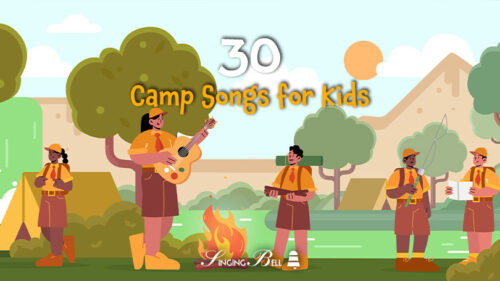This guide about the basic guitar chords for beginners will come in handy.


Embarking on the journey of learning the guitar is akin to stepping into a realm of endless possibility—a realm where melodies weave stories and chords build bridges between hearts. Yet, for the fledgling guitarist, the array of chords can seem daunting, like a dense forest begging to be navigated.
Fear not, for in this guide, we unveil the compass to your musical exploration, the essential guitar chords for beginners.
Table of Contents
- Why Learning Guitar Chords is Important
- Overview of Essential Guitar Chords
- How to Play Each Chord
- More guitar blog posts
- Practice Tips
- Common Chord Progressions
- Troubleshooting Common Guitar Chord Issues
- Additional Resources
- Conclusion
Why Learning Guitar Chords is Important
Chords serve as the building blocks of music, the scaffolding upon which songs are constructed. Mastery of basic chords lays a solid foundation for further progress, empowering you to strum along to your favorite tunes, write your own compositions, and explore the vast landscape of musical expression.
Overview of Essential Guitar Chords

Let’s unveil the stars of our show: Am, E, Dm, and Em.
These humble yet powerful chords are the bedrock upon which countless songs are built.
The Am chord exudes a melancholic charm, while E bursts forth with vibrant energy. Dm lends a touch of introspection, and Em carries an air of wistful longing.
Each chord possesses its unique aura, ready to infuse your music with depth and emotion.
How to Play Each Chord
A minor
To play the Am (A minor) chord, position your index finger on the first fret of the B string, your middle finger on the second fret of the D string, and your ring finger on the second fret of the G string.
Ensure that each finger is placed close to the fret wire for clear notes and avoid touching adjacent strings. When strumming, focus on keeping a light touch while still applying enough pressure to produce a clean sound.
E major
For the E (E Major) chord, position your index, middle, and ring fingers on the first, second, and third frets of the G, A, and D strings respectively.
Ensure that your fingers are arched and not touching the adjacent strings, allowing each string to ring out clearly. Keep your wrist relaxed and your thumb positioned behind the neck for stability.
More guitar blog posts
D minor
To play the Dm (D minor) chord on the guitar, position your index finger on the first fret of the high E string, your middle finger on the second fret of the G string, and your ring finger on the third fret of the B string.
Ensure firm pressure on the strings and strum from the D string downward, avoiding the low E string.
E minor
For the Em (E minor) chord, place your index finger on the second fret of the A string, and your middle finger on the second fret of the D string. Strum all six strings starting from the low E string (the thickest string) down to the high E string (the thinnest string).
Practice Tips

Consistent practice is key to mastering the essential chords. Keep these 3 in mind:
1
Start by practicing each chord individually, ensuring clean and clear sounds with each strum.
2
Gradually increase the tempo as you gain confidence, and challenge yourself with chord transitions and alternate strumming patterns.
3
Remember to relax your fingers and maintain proper posture to avoid fatigue and injury.
Common Chord Progressions

The essential chords form the backbone of countless songs and chord progressions.
From the classic Am-E progression found in folk and pop music to the haunting beauty of Dm-Em in ballads, these chords open doors to a world of musical possibilities.
1 – The Melancholic
Chord Progression:
Am – Dm – E – Am
This progression has a somber and introspective feel, perfect for ballads or reflective pieces.
2 – The Uplifting
Chord Progression:
Em – Am – E – Am
This progression starts with a minor tone but resolves to a more hopeful and uplifting sound, suitable for songs with a journey-like narrative.
3 – The Dramatic
Chord Progression:
Dm – Am – E – Am
This sequence creates a dramatic and tense atmosphere, ideal for conveying strong emotions or climactic moments in a song.
4 – The Introspective
Chord Progression:
Am – Em – Dm – Am
This progression provides a contemplative and introspective mood, often used in pieces that require a thoughtful and reflective tone.
5 – The Expressive
Chord Progression:
Em – Dm – Am – E
This progression allows for expressive dynamics and emotional depth, making it versatile for various song themes, from longing to resolution.
Experiment with different progressions and explore how each chord interacts with the others to create harmony and emotion.
Troubleshooting Common Guitar Chord Issues

As you embark on your chord journey, you may encounter challenges and frustrations along the way.
Common issues include buzzing strings, muted notes, and difficulty with chord transitions.
Buzzing Strings
Explanation:
Buzzing strings occur when the string isn’t pressed down firmly enough against the fretboard, or when it’s touching a fret unintentionally. This results in a vibrating or buzzing sound instead of a clean note.
What to Do:
- Ensure that you are pressing down firmly on the string with the tip of your finger, close to the fret but not directly on it.
- Check that your finger position is correct and adjust if needed.
- Make sure your guitar setup is correct, with the action (string height) not too low, which might require professional adjustment.
Muted Notes
Explanation:
Muted notes happen when a finger inadvertently touches an adjacent string, preventing it from vibrating properly. This results in a muffled or dead sound.
What to Do:
- Position your fingers so that they are arching more, allowing the tips to press the strings without touching others.
- Practice slowly and deliberately to ensure each string rings out clearly when playing a chord.
- Adjust your hand and wrist position to find a comfortable angle that avoids muting other strings.
Difficulty with Chord Transitions
Explanation:
Switching between chords can be challenging, especially for beginners, leading to hesitation or incomplete chord shapes during transitions.
What to Do:
- Practice moving between chords slowly and gradually increase your speed as you become more comfortable.
- Break down the transitions into smaller movements and practice each step repeatedly.
- Use a metronome to help maintain a steady rhythm and improve your timing.
- Spend extra time on particularly difficult transitions, isolating them until they become more fluid.
By addressing these common issues individually, you can make your chord playing cleaner, more accurate, and enjoyable as you progress on your guitar journey.
Remember that progress takes time and patience, and don’t be afraid to seek guidance from online tutorials, instructional books, or experienced guitarists. With perseverance and determination, you’ll overcome any obstacles that stand in your way.
Additional Resources
For further guidance and inspiration, explore a variety of resources tailored to beginner guitarists.
Online tutorials, such as those offered by reputable music websites and YouTube channels, provide step-by-step instructions and demonstration videos to supplement your learning.
Here are five websites offering online guitar courses:
- Guitar Tricks: https://www.guitartricks.com/
- TrueFire: https://www.truefire.com/
- Fender Play: https://www.fender.com/play
- JustinGuitar: https://www.justinguitar.com/
- JamPlay: https://www.jamplay.com/
These are five YouTube channels offering guitar tips:
- Marty Music: https://www.youtube.com/@MartyMusic
- JustinGuitar: https://www.youtube.com/@justinguitar
- Paul Davids: https://www.youtube.com/@PaulDavids
- Good Guitarist: https://www.youtube.com/@Good_Guitarist
- Dr. Jaxon Williams – Concert Guitarist: https://www.youtube.com/@drjaxonguitar
Books and instructional DVDs offer comprehensive lessons and exercises to help you hone your skills at your own pace.
Additionally, consider downloading guitar apps that offer interactive lessons, chord libraries, and backing tracks for practice sessions on the go.
Last but not least, Singing Bell’s Guitar section for beginners includes separate index pages on how to play Children’s Songs and how to play Christmas Songs.
Conclusion
In conclusion, mastering the essential guitar chords is a milestone in your musical journey, opening doors to creativity, expression, and connection. Whether you aspire to strum along to your favorite songs, write your own compositions, or jam with friends around the campfire, these chords serve as your faithful companions every step of the way.
Remember to practice regularly, stay patient, and never lose sight of the joy and passion that drew you to the guitar in the first place. With dedication and perseverance, the world of music is yours to explore and conquer.
Did you like this post? Rate it!
You might also like:



















